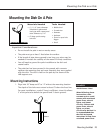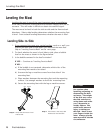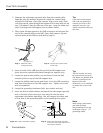
28 Final Installation
CAUTION
Use caution when
installing, adjusting or
dismantling the dish
and mast. The weight
of the dish may cause
the dish and mast to
swing down and strike
you, a bystander or
nearby objects. This
could cause personal
injury or damage to
the dish. Never insert
your fingers inside the
mast. Always grip the
mast around its outside
circumference.
Leveling the Mast
Leveling the mast is one of the most important steps in installation.
If the mast is not level, the elevation and azimuth settings will not be
accurate. This will make it difficult to obtain the satellite signal.
The mast must be level in both the side-to-side and the front-to-back
directions. Side-to-side leveling determines whether the mounting foot
is level. Front-to-back leveling determines whether the mast is level.
Leveling Side-to-Side
1. If you mounted the mast on a vertical surface, such as a wall, you
leveled the mast side-to-side when you mounted the mast foot.
Skip to “Leveling Front-to-Back” on the next page.
2. To check whether the mast is level side-to-side, place a bubble
level on the mast as shown in the figure below.
3. Is the bubble centered in the level’s window?
If YES — Continue to “Leveling Front-to-Back”.
If NO —
a) If the bubble is not centered, determine which side of the
mounting foot needs to be raised.
b) Unscrew the lag or machine screws from that side of the
mounting foot.
c) Place washers between the mounting foot and the mounting
surface. Use enough washers to level the mounting foot.
d) Secure the mounting foot with the lag or machine screws.
Leveling the Mast
Level Not Level
Step 2: Verify that the mast is level
side-to-side.
Step 3: If the mast is not level, add
washers to level the foot.


















